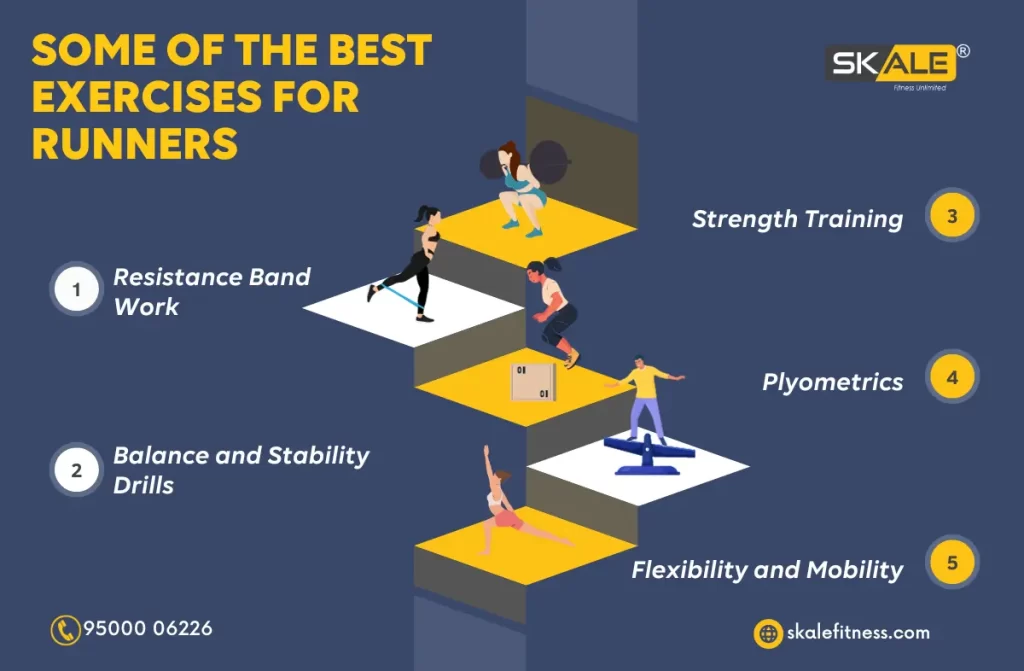Best Exercises for runners, you’re no stranger to the thrill of hitting the open road, the rhythmic sound of your footfalls, and the sense of freedom that comes with every stride. However, focusing solely on running can lead to imbalances in your body and increase the risk of overuse injuries. That’s where cross-training comes in. Incorporating a variety of exercises into your routine can improve your overall fitness, strengthen your muscles, and prevent boredom.
The Importance of Running Strength Exercises
Strengthening your legs, core, and arm muscles offers multiple benefits for running performance. Enhanced arm muscles add more power and thrust to your stride. Improved core and upper body strength increases torso stabilization, reduces wobbling while running, and conserves energy. Additionally, strength training helps prevent injuries by boosting endurance and overall performance.

Strength Training for Runners
Good exercises for runners should include strength training. This well-kept secret can significantly enhance your running performance, enabling you to run faster, cover longer distances, and reduce the risk of injuries. Here are some key exercises every runner should consider:
- Squats: Squats stand out as one of the best exercises for runners. They are a fantastic full-body workout that effectively targets your quadriceps, hamstrings, glutes, and lower back. Developing strong leg muscles through squats is essential for maintaining proper running form and generating the necessary power. Including squats in your exercise routine can significantly enhance your running performance.
- Lunges: Lunges work on your balance, stability, and leg strength. They are especially effective at targeting the muscles used during running. Incorporate forward, reverse, and lateral lunges into your workouts to keep your leg muscles engaged and strong.
- Planks: Core strength is essential for maintaining proper running posture and preventing back pain. Try variations like side planks and forearm planks to work different parts of your core.
- Push-ups: Upper body strength may not seem crucial for runners, but it plays a role in maintaining proper posture and arm swing. Push-ups help develop your chest, shoulders, and triceps, making your upper body more resilient during long runs.
Maximize your running performance with the Best Exercises For Runners. Perform exercises with proper form, gradually intensify, and include strength training at least twice a week to prevent injury and achieve optimal results.
Benefits of Strength Training for Runners
Core Strength: Strength training, using bodyweight or added weights, builds leg muscles and core strength, enabling your body to sustain faster speeds with ease and maintain strong posture when fatigue sets in.
Reduced Injury Risk: Developed muscles protect bones and joints, lowering the chance of stress fractures and other running injuries. Additionally, weight training enhances bone density and strengthens connective tissues, reducing the risk of tears and breaks.
Exercise Examples:
Squats:
- Stand with feet hip-width apart, toes slightly out.
- Simulate sitting on an invisible chair, looking up.
- Keep your back neutral, avoiding leaning too far forward; knees should not surpass toes.
- Extend arms for balance.
- Perform 10 repetitions.
Lunges:
- Start with feet shoulder-width apart, core engaged, and shoulders back.
- Step forward with your left leg, lowering into a lunge until the front knee is at about 90 degrees.
- Push back to the starting position and alternate legs.
- Do 10 repetitions per leg.
Deadlifts:
- Position a barbell in front of you, standing so the middle of your foot is under the bar.
- Bend your knees until shins touch the bar, keeping it over your foot’s middle.
- Lift your chest, straighten your back, and stand up, keeping the bar close to your legs.
- Lower the bar to the ground gently, repeating for 10 repetitions.
Speed Sessions:
- Incorporate weekly speed sessions to build joint and muscle strength and power.
- Perform 1 minute of intense effort followed by 2 minutes of recovery walking or light jogging.
- Repeat 10 times and ensure proper warm-up and cool-down routines to minimize injury risk.
Long Runs:
- Include long runs in your weekly routine to enhance endurance and distance.
- Gradually increase the distance by no more than 10% each week to prevent overtraining. For instance, if you run 5 miles in week one, aim for 5.5 miles in week two.
Integrating strength training into your running regimen can lead to better performance and less risk of injury, making it a crucial component for both novice and experienced runners.
Flexibility and Mobility Exercises
Good exercises for runners aren’t limited to strength training; flexibility and mobility are equally important. Here are some exercises to keep you limber:
- Hip Flexor Stretch: Among the best exercises for runners, regular hip flexor stretching is crucial. This practice helps maintain flexibility and prevent discomfort during your runs, as tight hip flexors can contribute to poor running form and lower back pain.
- Calf Stretches: The calf muscles play a crucial role in running. To avoid calf strains and maintain flexibility, incorporate calf stretches into your pre- and post-run routine.
- Yoga or Pilates: These disciplines focus on overall body flexibility and core strength. Incorporating yoga or Pilates into your weekly regimen can help you maintain a well-rounded level of flexibility and strength.
- Foam Rolling: Using a foam roller to perform self-myofascial release can help relieve muscle tension and improve your range of motion. Focus on rolling out your quadriceps, hamstrings, and IT band, which are commonly affected by runners.
Enhance your running performance with the Best Exercises For Runners including flexibility and mobility exercises. Reduce injury risk and maximize your running enjoyment through regular flexibility and mobility routines.
Best Exercises For Runners: Plyometric Training
Plyometric exercises are explosive movements that can enhance your running power and speed. Here are some plyometric exercises that are good for runners:
- Box Jumps: Box jumps are among the best exercises for runners, as they are highly effective for developing explosive leg strength, which mimics the power required for activities like sprinting and hill climbs.
- Jumping Lunges: Jumping lunges combine the benefits of lunges with the explosive power of plyometrics. This exercise will help you improve your leg strength and speed.
- Bounding: Bounding involves leaping forward while maintaining a strong running form. It enhances your stride length and power, making it a great exercise to incorporate into your routine.
- Hurdle Hops: Hurdle hops simulate the action of hurdling, which can help improve your running stride and leg strength.
Plyometric exercises should be done with caution, as they put extra strain on your joints. Start with low-intensity variations and gradually progress to more advanced movements as your strength and stability improve. Plyometrics are excellent for enhancing your running performance and injecting some fun into your training routine.
Running Performance Tips
- Warm-Up and Cool-Down: Start with a proper warm-up to activate muscles and prevent injuries, followed by a thorough cool-down to aid in recovery.
- Hydration: Stay hydrated by drinking water before, during, and after runs. According to Runner’s World, subtract your post-run weight from your pre-run weight and convert to milliliters to determine how much fluid you should be drinking (1 gram = 1 milliliter).
- Balanced Diet: Fuel your body with healthy carbohydrates, lean proteins, fruits, vegetables, and healthy fats. Follow a balanced diet as recommended by John Hopkins Medicine.
- Compression Gear: Use CW-X Endurance Generator Joint & Muscle Support Compression Tight to aid in faster recovery times and prevent injury during and after workouts.
Running-Specific Drills
In addition to general strength, flexibility, and plyometric exercises, running-specific drills can help you fine-tune your technique and performance. Incorporating these drills into your routine can lead to significant improvements in your running form and efficiency:
- Strides: Strides are short, controlled sprints performed at the near-maximum effort. They help improve your running mechanics, speed, and form. Incorporate strides into your warm-up or cool-down routine.
- Hill Repeats: One of the best exercises for runners is hill repeats. This workout entails running uphill at a challenging pace and then jogging or walking down to recover. Hill repeats effectively build strength and endurance while enhancing your ability to conquer inclines, making them a valuable addition to a runner’s training regimen.
- Interval Training: Improve your running with the Best Exercises For Runners, including Interval Training. This method alternates high-intensity sprints with rest, enhancing cardiovascular fitness and speed.
- Form Drills: These drills focus on specific aspects of your running form, such as arm swing, foot strike, and cadence. Consistently practicing form drills can lead to more efficient running and fewer injuries.
Benefits of Strength Training for Runners
Strength training offers numerous advantages for runners, enhancing performance and reducing injury risks:
- Improved Running Economy: Strengthening muscles can enhance running efficiency, helping you cover more distance with less effort.
- Injury Prevention: Building strength in supporting muscles can reduce the likelihood of common running injuries, such as knee pain, IT band syndrome, or shin splints.
- Increased Power and Speed: Stronger muscles generate more power, boosting speed and sprinting abilities.
- Better Muscle Balance: Strength training helps balance muscle development, preventing muscle imbalances that can lead to injuries.
- Enhanced Endurance: Improved muscular endurance can delay fatigue during long-distance runs.
- Core Stability: A strong core contributes to better posture, stability, and form, which are crucial for efficient running mechanics.
- Faster Recovery: Strong muscles recover more effectively after workouts, reducing post-run soreness and aiding in quicker recovery.
- Bone Density Improvement: Resistance training can help enhance bone density, reducing the risk of stress fractures common in runners.
Conclusion
For runners, incorporating a diverse set of exercises into their routine is vital for improving performance and overall health. While consistent mileage is important, the inclusion of various exercises is equally beneficial. Some of the best exercises for runners encompass strength training, flexibility and mobility workouts, plyometrics, and running-specific drills. By integrating these exercises into your training plan, you can enhance your running capabilities and lower the risk of injury.




